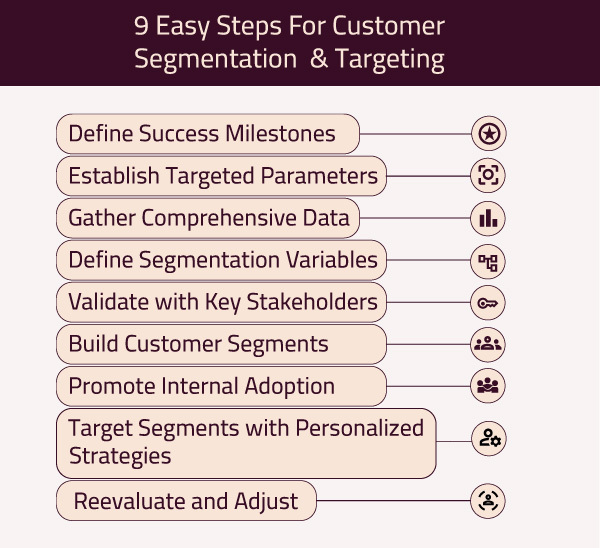
An Outbound Guide for Strategic Segmentation and Targeting
Prospect segmentation and targeting are like the yin-yang of outbound marketing. When you segment your Ideal Customer Profile (ICP) or customer base, you create the best-targeted outreach approach ever!
According to a recent study by MarketingSherpa, companies that use targeted marketing experience a 760% increase in revenue. That sounds amazing!
So, in this blog post, we'll explore the best ways to leverage segmentation and targeting. We'll also explore the benefits of creating segments, particularly in outbound marketing, and discuss various types of segmentation.
But that's not all! You will also get pro tips in between. So, let's start our guide.
First, let us see how prospect segmenting and targeting your target audience go hand in hand.
The Close Connection Between Segmentation and Targeting
These terminologies are two sides of the same coin in outbound marketing. Segmentation involves dividing the market into distinct groups based on specific criteria. Meanwhile, targeting focuses on tailoring marketing efforts to the most viable segments.
The synergy between these two processes ensures efficient promotional activities resonate with your intended audience.
Benefits of Segmenting And Prospect Targeting in Outbound Marketing
Did you know segmented campaigns achieve 14.31% higher open rates and 101% more clicks than non-segmented ones? It's because you receive many benefits while implementing segmentation regarding your targeting capacity. Some of them are as follows:
- Enhanced Personalization: Tailoring your brand messages to specific segments allows for more personalized and targeted communication. Thus, it increases the likelihood of your prospects' engagement.
- Improved Customer Retention: You get to understand and address the unique needs of different segments. Thus, you can create content that directly targets their needs.
It can increase customer satisfaction and long-term loyalty, as 72% of consumers want businesses to recognize their interests/needs.
- Optimized Marketing Resources: Target-specific segments ensure your marketing efforts are directed where they are most likely to yield positive results. Thus, you prevent wasted resources.
- Increased Conversion Rates: When you craft messages that resonate with a particular segment's preferences and behaviors, you boost your conversion rates. How? 91% of consumers purchase from brands that provide relevant offers and deals.
- Better Product Development: Insights from segmentation give you an informed direction toward your product development. It ensures your offerings align with target customer needs and preferences.
- Competitive Advantage: Targeting niche segments allows you to differentiate your brand in a crowded market. Hence, you gain a competitive edge.
- Easier Market Expansion: You get an understanding of diverse segments. By tailoring strategies to local needs and preferences, segments facilitate your brand's successful expansion into new markets.
- Data-Driven Decision-Making: Through segmentation, you get valuable data, which allows you to make informed decisions based on real customer insights. The brands leveraging such customer data are 23 times more likely to acquire customers.
5 Prime Types of Segmentation
You can divide your potential customers into different segment types for better targeting.
Rightly segmented, triggered, and targeted campaigns contribute to 77% of marketing ROI!
Thus, you must know which segments you must choose. Here are the 5 essential ones to know:
1. Demographic Segmentation (Geographic Segmentation)
It involves dividing the market based on the demographic elements of your target audience:
| Demographic Element | Examples |
| Age | 18-24, 25-34, 35-44, etc. |
| Gender | Male, Female, Non-Binary |
| Income | Low, Middle, High |
2. Behavioral Segmentation (Psychographic Segmentation)
It categorizes consumers based on their conduct and actions while making purchases: .
| Behavioral Element | Examples |
| Buying Behavior | Regular, Occasional, First-time |
| Preferences | Brand loyal, Price-sensitive |
| Usage Patterns | Heavy user, Light user |
3. Technographic Segmentation
It considers the technological tools and platforms that your target customers use.
| Technographic Element | Examples |
| Software Preferences | Windows, Mac, Linux |
| Device Usage | Desktop, Laptop, Mobile |
4. Media Preference Segmentation
It involves categorizing target consumers based on their preferred communication channels and media.
| Media Preference Element | Examples |
| Social Media Platforms | Linkedin, Facebook, Instagram, Twitter |
| Communication Channels | Email, SMS, Phone |
5. Firmographic Segmentation
This segmentation type involves categorizing businesses based on various firmographic elements.
| Firmographic Element | Examples |
| Industry | Healthcare, Technology, Finance |
| Company Size | Small, Medium, Large |
| Location | Local, National, International |
Though these 5 types are a must consideration, you can further amplify your segment-based targeting with advanced categorization.
Advanced Segmentation Types
Check out these three pro segment types:
1. Needs-Based Segmentation
You are required to categorize prospects according to their everyday needs rather than relying on factors such as age or location. Recognizing shared needs gives you insights into reasons influencing your target customers' purchasing decisions related to that specific need.
2. Value-Based Segmentation
It requires you to focus on grouping customers based on their shared values, beliefs, and ethical considerations. Some of the best examples are environmental consciousness and social responsibility.
3. Benefit-Based Segmentation
You need to categorize consumers based on the specific benefits they seek from a product or service. Examples may include time-saving benefits, cost-saving benefits, etc.
Now, let us explore how you can segment and target your consumer base effectively.
Steps to Create an Effective Prospect Segmentation and Targeting Strategy
Follow the below-given steps to build affluent market segments:

1. Define Success Milestones
Understand the objectives behind your segmentation strategy. It is a crucial step that clearly defines the following:
- Problems you aim to solve
- The desired outcomes
- What success looks like for your brand
2. Establish Targeted Parameters
Next, set specific parameters to manage your target market segmentation. For example:
- Determine the number of segments you plan to create
- Identify the data sources you will use, etc
This step lays the foundation for a focused and effective segmentation process.
3. Gather Comprehensive Data
Initiate the segmentation process by collecting relevant customer data from designated external and internal sources. Ensure the data gathered aligns with the parameters set in the previous step to facilitate accurate segmentation.
4. Define Segmentation Variables
Choose the variables or characteristics that you wish to use for segmenting customers. Options include demographic traits, firmographics, behavioral patterns, and more. This step helps structure your segmentation approach.
5. Validate with Key Stakeholders
Before proceeding, consult with key stakeholders to validate the chosen segmentation variables. Confirm that their expectations align and that everyone is on the same page. This collaboration ensures a more holistic and accurate segmentation process.
6. Build Prospect Segments
Execute the segmentation process based on the defined parameters and variables. Create distinct market segments that reflect the diverse characteristics identified during the data-gathering phase.
7. Promote Internal Adoption
Encourage different business units to adopt and focus on selected market segments. Ensure your team uses the created segments when making strategic decisions. This step enhances organizational alignment and efficiency.
8. Target Segments with Personalized Strategies
Leverage the segmented data to develop:
- Personalized marketing campaigns
- Targeted sales outreach and other materials tailored to each specific market segment.
It ensures a more resonant and impactful engagement.
9. Reevaluate and Adjust
Regularly solicit feedback from various teams to assess the effectiveness of the segmentation strategy. Identify what is working well and areas that may need adjustment. Use this feedback loop to refine and optimize prospect segments continuously.
Conclusion
Navigate 2024 with strategic segmentation and propsect targeting in your outbound marketing strategy. It can do wonders for your aim to stay competitive and connect with your audience on a deeper level. Plus, you can yearn for precise, effective, and yield optimal results.
Having a helping hand of experts in segmented marketing can turbocharge your approach. Partner with Revnew, the best outbound marketing agency!
Our expert team is equipped with the needed knowledge to help you lay out targeted outreach campaigns. To know more, contact us here.




